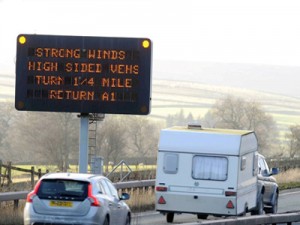Caravanning in adverse weather
Using your caravan off-season can bring many new rewards to caravanning, whether it’s cheaper discounts on your favourite sites or new vistas to look out across as the seasons change. However, the changing weather can bring new risks to your holiday, so make sure that you are prepared for all the dangerous conditions that you may face.
Over the last few years, the UK has experienced severe weather warnings. Whilst the subject of climate change is still hotly debated, we have experienced very dangerous weather conditions, from the incredible snow coverage we saw a couple of winters ago to the recent high winds that have battered the UK.
Each different weather condition brings its own dangers; we’ve looked into the most dangerous common weather and how to prepare for it:
Strong winds
 This is one of the most dangerous weather conditions when towing a caravan, and often overlooked. Strong winds can be dangerous whether you’re towing, set up on a pitch or even in storage. In a recent survey by our insurance arm, Club Care, approximately 4% of Club Care Insurance claims are attributed to high winds ranging from minor damage to a write off in the most extreme cases.
This is one of the most dangerous weather conditions when towing a caravan, and often overlooked. Strong winds can be dangerous whether you’re towing, set up on a pitch or even in storage. In a recent survey by our insurance arm, Club Care, approximately 4% of Club Care Insurance claims are attributed to high winds ranging from minor damage to a write off in the most extreme cases.
When towing it is always best to try and avoid strong winds. The common dangers of towing, such as snaking and overturning, become much more significant in high winds. Strong winds may cause your caravan to become unstable. Even if you’re towing at a steady speed on a level road, a strong gust of lateral wind may cause your caravan to begin to snake. Club Care Insurance reports that around 10% of claims can be attributed to snaking incidents.
If you’re on holiday, make sure that your awning is securely fastened and tied down. If you have time before the strong winds arrive, try to take down the fabric and store it safely. However, don’t try this if there is any risk of the high winds appearing whilst you’re working, as this could cause serious injury.
Caravan towing in snow and ice
 It is never recommended to tow a caravan in snowy or icy conditions but if you are caught up in the snow it is always best to stay calm and take it slow.
It is never recommended to tow a caravan in snowy or icy conditions but if you are caught up in the snow it is always best to stay calm and take it slow.
As you are probably aware from driving a car in snow and ice, loss of traction is one of the biggest dangers. This is amplified when you’re towing, as you are pulling a much greater weight. Reducing your speed, increasing your braking time and making all your movements slow, steady and deliberate should help you reduce the chances of anything going wrong.
Plan ahead and try to stick to major roads, as these are more likely to be properly gritted and will have more traffic to melt the snow, hopefully improving the available grip on the road surface.
Steep hills and sharp bends should be avoided as often as possible; these are usually the most treacherous areas.
If you have a 4×4 don’t assume that you are safe. The extra traction available will increase your chances of a safe drive, but you should still take the same precautions as anyone else.
Snowy conditions are also a perfect camouflage for most caravans, as the running joke goes: “Would you like your caravan in white, or white?” The outline of your caravan can become difficult to determine in snow. If you do have to drive in severe snow, you could consider ways of increasing your caravan’s visibility, perhaps consider adding some fluorescent stickers to the extremities of the caravan.
Rain and floods
 Although rain is a common sight in the UK and we often have to travel through heavy rain, it pays to remain vigilant. Remember that braking distances and cornering speeds are affected on damp or wet surfaces.
Although rain is a common sight in the UK and we often have to travel through heavy rain, it pays to remain vigilant. Remember that braking distances and cornering speeds are affected on damp or wet surfaces.
In severe rain, the roads can often become flooded. As soon as a surface is submerged in water a new danger occurs, aquaplaning. This is when the wheels lose contact with the road, which can result in almost complete loss of traction. Try to avoid roads with visible standing water. You can decrease the chances of aquaplaning by reducing your speed and acceleration, braking and steering gently and making sure your tyre treads are adequate and pressures are set to the manufacturers’ recommendations. Remember to account for the increased braking distances, especially if you have to brake more gently.
Hard rain can also have a massive impact on visibility. If the rain is affecting your ability to see the road and other vehicles, or you find that you can no longer clearly distinguish the edges of the caravan in your mirrors then you should try to find the nearest service or rest station and wait out the worst of it.
Stay safe people – The Big White Box Team
